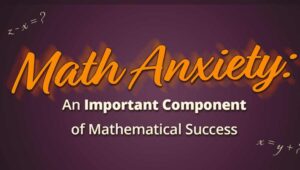
Study Time: 4minutes
Mathematics Anxiety (Part-2)
An attitude of learning math helps students to know and develop self-assurance in their skill and performance in math. Students should eliminate some myths about math like high-level math is difficult or men are better than women in math. Gender has an influence on math anxiety. Some findings prove males have higher math anxiety than females until junior high school. Even though females can do arithmetic math better than males, boys tend to show the advantages of math achievements. Journal writing helps students understanding math concepts and allows them to share their feelings and experiences with math (Furner). Researchers recommend that students should practice math daily and study new techniques. Students must study in a place with less stress and learn math in an individual style. If the students need extra help, it is better to use tutors or others rather than their teachers or classmates. Also, some relaxation techniques such as positive messages reduce math anxiety in the students (Blazer).
Fear of math can transfer to the next generation. Parents’ role is important to change attitudes toward math. Family Math Nights mean a family can do mathematics together and is a way to bring families to the classrooms of their children. Parents learn about approaches to learning math and problem-solving. They should seek positive ways to support their children and teachers (Furner). Parents help children to believe they can succeed in doing the math and have the confidence to prevent math anxiety from occurring in the student. Then, the students love math and math will be their favorite subject. Parents could support and encourage their children and improve their confidence to succeed in math. Parents should monitor their children’s progress in math and have a realistic expectation of their children (Blazer).
Policymakers and designers of the curriculum should help to reduce math anxiety and increase the number of STEM teachers and students. In 2012, U.S. students ranked 20th and 27th in science and math in the world among their peers. President Obama set a plan for 100,000 new STEMs in 10 years (100Kin 10) in 2011 to improve teaching math, develop and recruit teachers. The teachers would receive training in math anxiety to help students and the next generation would have a positive attitude in math (Beilock).
The findings prove math anxiety is related to different factors. There are some differences between math anxiety and general anxiety. Intelligence is not related to math anxiety. It has a negative relationship with performance and competence, and it is not universal. Also, the reason for lower performance in math is that people are at a higher level of math anxiety. Attitude has a major role that causes people to avoid math. Recognizing math anxiety affects how quickly people can do math, especially when basic math involved borrowing or carrying. Also, cognition is dependent on working memory and motivation. A combination of various factors such as learning experience, biological talent, and attention toward math also, have influence in math anxiety (Ashcraft).
Different levels of math anxiety effect on students’ motivation and achievement in matriculation. Engineering students try to expand their acquaintance and learning in the math area, but they have negative attitudes toward math in the higher grades. Students with high motivation desire to do problem-solving, and they have low levels of math anxiety. (Zakaria).
In mathematics education, math anxiety plays an important role in learning math that cannot be ignored. The functions of teachers, parents, and students are helping to reduce math anxiety. They should find a way to have better math skills. Researchers emphasize to the general public that success in math is not related to math knowledge and concepts but also, people need to right mindset (Beilock). Including the development of teaching techniques, the description of math concepts in real life, and raise the student’s confidence to enjoy math.
For more information about math test visit our website.



